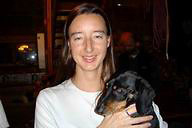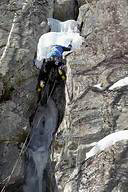Talus and Calcaneus
|
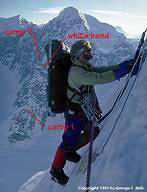 |
| Photo
by George I. Bell©
1985 |
In preparation, Rebecca and I upgraded to ultra light equipment which brought our packs to less than 30 lbs. (that is without ropes and climbing protection). Daily we hiked 1300 vertical feet of stairs while wearing mountain boots and 30 lbs. packs, and during the weekends we journeyed to Seneca Rocks, WV to maintain our mental stamina. At Seneca, we trained using an anemic alpine rack (that habitually forced 15 feet run-outs), became comfortable with using hand signals for communication in windy conditions, and practiced alpine aid climbing for anything harder than 5.8.
April 17 was one such Saturday at
Seneca. We left home at 6:30 am after chatting with the Houser’s who
were out walking Ms. Daisy. By 10:00 am, we
were hiking up Roy Gap Road towards the South End. 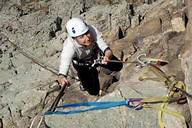 The day was
beautiful; sunny, 74 ºF with
a light breeze, and the rocks were unusually deserted. We climbed Totem
(5.11a) aiding through its roof and then, we moved
to Ye Gods and Little Fishes (5.8) where I reconsidered a
potentially grown-falling run-out after feeling less-than-comfortable
with the next move. Although Rebecca had an emotionally sensitive start
to her day, she was feeling much better after easily aiding the roof
of Totem and following Ye Gods without falling.
The day was
beautiful; sunny, 74 ºF with
a light breeze, and the rocks were unusually deserted. We climbed Totem
(5.11a) aiding through its roof and then, we moved
to Ye Gods and Little Fishes (5.8) where I reconsidered a
potentially grown-falling run-out after feeling less-than-comfortable
with the next move. Although Rebecca had an emotionally sensitive start
to her day, she was feeling much better after easily aiding the roof
of Totem and following Ye Gods without falling.
I considered asking Rebecca to lead Candy Corner (5.5), but by the time we got back to the ground, Tom Cecil had started teaching a class up it. "Let’s go and do the Burn" – I said to Rebecca. The Burn (5.8) is a climb that I have done more than a dozen times and well within my abilities. Its first half is a well protected face climb which ends at a ledge below an overhang; from there, a beautiful finger crack leads to the belay station 30 feet above. The climb has a reputation as an "ankle breaker" because many fall while trying to place protection at the crux of the finger crack and hit the ledge on their way down. This need not to be the case given that there is ample good protection available, but this Saturday, I wanted to climb it using as little protection as my courage could stand.
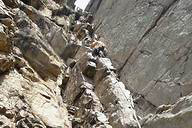 Five
feet from the top, with only one hard move left, something went wrong
(my best guess – one of my climbing shoes slipped) and I felt the
dynamic tug of gravity. I am used to falling and thus not afraid of it,
but in this fall, as time lapsed
and I accelerated towards terminal velocity, I knew that I was in
trouble.
As best as we can reconstruct the event, this is what happened.
Five
feet from the top, with only one hard move left, something went wrong
(my best guess – one of my climbing shoes slipped) and I felt the
dynamic tug of gravity. I am used to falling and thus not afraid of it,
but in this fall, as time lapsed
and I accelerated towards terminal velocity, I knew that I was in
trouble.
As best as we can reconstruct the event, this is what happened.
My fifth and last piece of protection was 15 feet below my feet, about 5 feet above the ledge. That meant that by the time I arrived at the ledge, I had free fallen about 20 feet, and still had at least 10 more feet to go before the rope arrested my fall. In perfect form, I hit the ledge with both feet, bounced from it, and continued my flight towards earth. Rebecca was caught by surprise by my fall and slammed into the rock wall by the rope which burned her hands as I came to a rest. And there I was, a big flopping fish and the end of a thin line.
A quick inspection revealed a bloody and larger than life right ankle. Rebecca was in shock but reacted well to my calm request to lower me to the ground. My left foot looked intact, yet it hurt when used to stabilize my descent over the rock wall. Rebecca asked for a damage report and I told her that I had a broken ankle. Once on the ground, the adrenaline surge made me shake like a leaf and I almost fainted. This lasted only a moment after which, I carefully removed my rock shoes and harness, and dressed my left foot with my approach shoe. There was no doubt, something was broken in my right ankle and it looked like it would need surgery. All I could tell Rebecca was – "well there goes the Alaska trip".
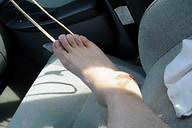 Rebecca was
understandingly very upset so
I tried to cheer her up – "I am fine, just a broken ankle. Let's be
quiet about it; not a word to anyone. Let's gather the backpacks and
get out of here." As I tried to stand on my left leg, I realized that
something was broken in my left foot. Crawling was going to be the only
way out. Climbers, who saw me fall, arrived at the Burn's belay station
and offered to clean the gear for us – I will forever be grateful to
those good Samaritans. I asked Rebecca to take Eddy and the packs, and to bring the Subaru up the Roy Gap Road where
I would meet her. Then I started crawling on my butt down the steep
wood stairs.
Rebecca was
understandingly very upset so
I tried to cheer her up – "I am fine, just a broken ankle. Let's be
quiet about it; not a word to anyone. Let's gather the backpacks and
get out of here." As I tried to stand on my left leg, I realized that
something was broken in my left foot. Crawling was going to be the only
way out. Climbers, who saw me fall, arrived at the Burn's belay station
and offered to clean the gear for us – I will forever be grateful to
those good Samaritans. I asked Rebecca to take Eddy and the packs, and to bring the Subaru up the Roy Gap Road where
I would meet her. Then I started crawling on my butt down the steep
wood stairs.
Thank God, I had no pain and very strong arms. I used an over-the-shoulder as a strap to keep the right knee anchored to my neck – that way the ankle was free hanging and out of harms way. For crawling, I would carefully place my hands on the ground, swing my butt forward, and lower my butt to the next step; then repeated the process. In five steps I had perfected the routine. A few people saw me crawling and offered to help, but I politely declined on the firm conviction the I had been stupid enough to get myself into this calamity, so I must be resourceful enough to get myself out of it. Twenty minutes later I was down by the creek. The creek was trickier – one false move and I would be carried by the current with the possibility of additional injury. Carefully, I shifted from dry rock to dry rock only getting my forearms wet. At the other side, Rebecca had just arrived; I was most pleased with my progress. I lifted my body into the car and we were off. No rescue, no show, and no Monday morning quarterbacking; 45 minutes after the accident we were on our way.
We agreed that it would be best to drive back to Washington given that I was likely to require a hospital stay. I moved to the back seat where my legs felt better and we started the 3-hour journey home. In Manassas, I phoned Vik who I knew would be a welcomed ally to Rebecca; he would meet us at Shady Grove Adventist Hospital. At the hospital, Rebecca found a wheelchair and I jumped into it with the help of my over-the-shoulder. In the emergency room the people parted in front of me as the waters of the Red Sea did in front of Mosses – the sight of my ankle was more than anyone could bear. I was brought in immediately and morphine was offered (by then, four hours later, it was starting to hurt). Lucky for me, Steve Bernstein, from Metro Orthopedics & Sports Therapy, was at the hospital attending to the broken ankle of another weekend warrior and he stabilized my feet.
"You have a very simple fracture of the left Calcaneus (i.e., the heel bone), but you have a serious fracture of the right Talus bone" – Dr. Bernstein explained. "Would you need to fuse my ankle?" – I asked. "No, the talus was not crushed and with some luck I should be able to surgically reduce it and hold it in place with two screws. I could do the operation early this week or you could be admitted and I will operate tomorrow morning" – he said. "Will I climb again?" – I tentatively asked. "Yes" – Dr. Bernstein replied with assurance.
 It will be a
long
recovery and a satisfactory outcome is by no means assured. In
the days since the accident, many who love me have implored me to stop
climbing. My parents are especially upset viewing the accident as
a final warning. Others have been turned-off by my refusal to be
helped with my daily tasks while on the wheelchair. I don't mean to
be disrespectful or ungrateful. Rather, I seek to be fully accountable
for my choices, so later I can live comfortably with them.
It will be a
long
recovery and a satisfactory outcome is by no means assured. In
the days since the accident, many who love me have implored me to stop
climbing. My parents are especially upset viewing the accident as
a final warning. Others have been turned-off by my refusal to be
helped with my daily tasks while on the wheelchair. I don't mean to
be disrespectful or ungrateful. Rather, I seek to be fully accountable
for my choices, so later I can live comfortably with them.
Above most everything else in life, I
value my climbing – admittedly, a most trivial and selfish endeavor. I
choose to climb because only by
exposing myself to this level of risk, I can bring into perspective
all the tribulations that life brings. I am afraid that without
climbing,
I would be like so many others who view choices related to health,
work, relationships, parenting, etc. as life all-encompassing
decisions.
Perhaps for then, this is a good way to carry on, but for me a life
without climbing would lack the clarity that I need.
![]() Pedro I. Espina©
2004
Pedro I. Espina©
2004
